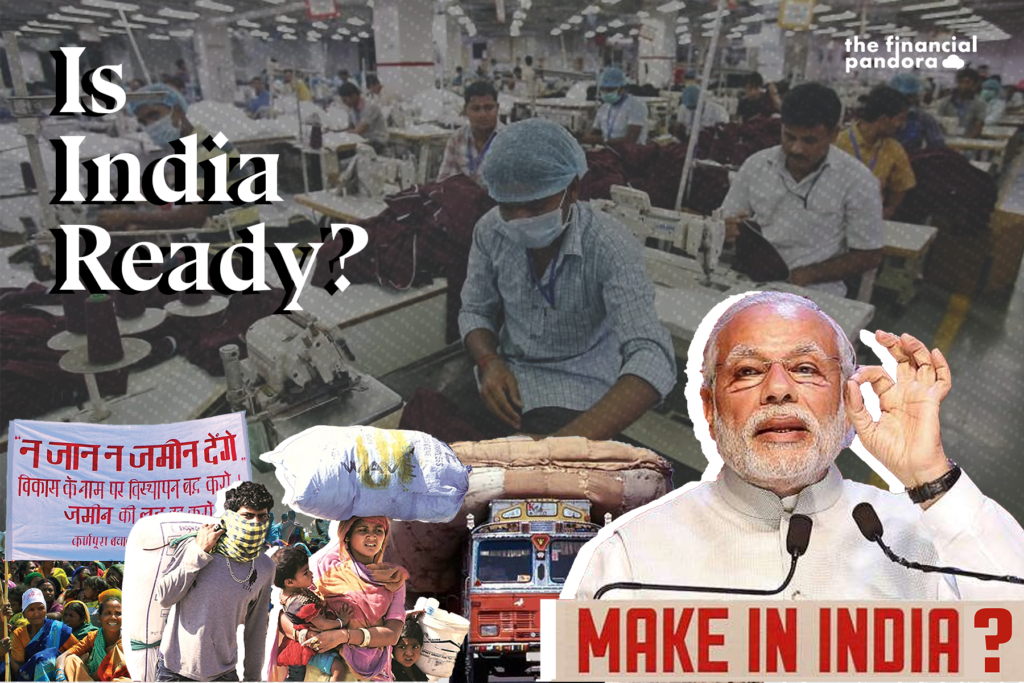Indians cheer when they read that Japan will incentivize companies to move out of China or news articles predicting that China may not be able to retain its position as the world’s largest factory in the post-Covid era. To add, the policymakers are also devouring this (over) optimism. “China’s weakened global position is a ‘blessing in disguise’ for India to attract more investment” said Mr. Nitin Gadkari, Minister of Road Transport and Highways of India, in an interview recently.

But isn’t it too early to party? Let’s do a fact check of such opportunity in past – which ostensibly was coming to India but took a detour to other Asian countries. According to Nomura’s report, out of 56 companies that relocated their production out of China between April 2018 and August 2019, only 3 came to India; 26 of them relocated to Vietnam, 11 went to Taiwan and 8 to Thailand.
So, the big question – Is India prepared to exploit the opportunity created by this geopolitical shift?
Let us dig deeper in areas where India needs key reforms to meet global investor’s expectations and bring them here to ‘Make in India’.
1. Land
While India may be moving at a fast pace in enhancing its ease of doing business rankings, but our land acquisition dampeners are still infamous amongst the global business community. A quick comparison of Tesla’s China plant being operational in less than 2 years of signing agreement with the Government vis-à-vis Suzuki’s Gujarat plant taking more than 5 years for the same, reveals the state of land acquisition ease in India. These cost and time overruns are too huge for businesses to invest in India.
World Bank’s ‘Doing Business 2020’ report ranks India 154 out of 190 countries under the parameter ‘Registering property in India’. As per the report, it takes 68 days in Mumbai to register a property and costs 7.8% of the property value. In contrast, registering a property takes only 9 days and costs 4.6% in China (ranked 28) and the same process takes 53 days in Vietnam (ranked 64) with only 0.6% cost. This reflects the competitive edge of other nations compared to India under this parameter.

India needs to adopt multi-dimensional means to solve this critical barrier in bringing manufacturing investments in India. Amongst other measures, land pooling by Government akin to the Andhra Pradesh model could be tested in other states as well to create plug and play styled business parks for foreign investors. Also, a separate Tribunal level judiciary should be setup to fasten the resolution for land-related litigation.
A primary reason for traction by rural landowners is their dependency on agriculture and lack of any other source of income. The government should focus on vocational training of the rural population in consultation with proposed investors. Simultaneously, the government should enter into agreements with the proposed investors to reserve a percentage of semi-skilled positions for the local community. This will encourage the rural population to sell their land as they can foresee an income-generating prospect for themselves even after parting with their land.
2. Labour
India has more than 200 labour laws enacted by Central and State Governments to protect the 45-crore workforce of the nation. However, the irony is that the same set of archaic laws are responsible for 90% of the workforce to persist in informal/ unorganised sectors. Most of them are paid below the minimum wage rates, receive no social security and remain out of the purview of the 200+ laws created for them.
Recently, there has been an action from the Central Government’s end to consolidate 44 central labour laws into 4 codes. Albeit, experts are having a positive outlook that the new code will give leeway to the employers dealing with workers and will simplify the stringent and complex compliance requirements. We will have to wait for the enactment of these codes and see whether they are able to simplify this key concern. Further, the state and local government will also have to take analogous actions simultaneously to ripe the fruits of the Central Government’s consolidation drive.
Taking advantage of the current situation, where foreign companies are inclined towards making investment in India, the Government can test run large-scale labour reforms in specific zones. Labour laws can be simplified for new manufacturing companies coming up in identified investment zones. Undeniably, basic labour rights such as minimum wage, lock-in of the minimum employment term, operational safety, social security need to be protected. However, impeding provisions giving legitimacy to trade unions of size as small as 10% of the work force can be amended to create a win-win situation for both employer and employee. Even the compliance mechanism can be moved from inspector-raj to self-assessment; this will substantially remove red tape and bureaucracy.
3. Logistics
India pays logistics cost as high as 14% of GDP and ranks 44 in the Logistics Performance Index in the world. The high cost is mainly due to lack of waterways as a means of transport and heavy dependence on road and railways. While railways cross-subsidize the passenger mobility segment, the road transport cost is high due to increasing toll charges and the inability to take credit of tax on fuel as the same is not under GST. Recently, in March 2020, the Government approved a new scheme ‘Remission of Duties and Taxes on Exported Products’, which covers reimbursement of non-GST taxes (including VAT on fuel used in transportation). This is a welcome step to make exports from India more competitive.
The implementation of GST has also been given a thumbs up by the industry as it has eased the interstate movement of goods.
The investors demand world-class technology-driven logistics infrastructure which speeds up the movement of goods within the country and internationally with efficient costs. The Government should work expeditiously towards long-pending Logistics policy, digitisation and bringing up a common IT platform to integrate all modes and operators, formalisation of truck industry and creating high end infrastructure. Nearly 60% of Indian logistics industry runs on the road which is remarkably high compared to global benchmarks. India should try to reduce this overdependence on road transport and shift to rail (do away with cross-subsidization) and waterways (develop water transport infrastructure). India should also encourage containerisation of local freight, which will increase the use of higher capacity multi-axle trailers as compared to small trucks and thus reduce per tonne cost of transport. This can be an important step to reach the target of reducing logistics costs under 10% of GDP.
4. Tariff and Taxes
India has fared well in attracting leading mobile companies (Apple, Samsung, Xiaomi, Oppo, Oneplus) to ‘Make in India – Sell worldwide’. This is partially due to India’s large domestic market for mobile phones and sector specific incentives by the Government. However, if we consider manufacturing led FDI in other sectors, ‘Make in India’ does not seem to be as grandeur as it was launched in 2014.

It is good that the Government is talking about manufacturing-led exports now; but, concurrently, the Government is becoming more protectionist. Aiming to grow into a global export hub and being protectionist – both cannot work in tandem. If a foreign company is setting up a manufacturing base in India for exports, its input cost would increase with higher tariffs on imports and thus make India financially less attractive. Thus, to become a global manufacturing hub, India needs to move away from being a protectionist and set competitive tariffs.
The global community has well appreciated Modi government’s decision to slash corporate tax rate to 15% for new manufacturing companies and 22% for existing ones. But merely reducing tax rates does not work. Vodafone’s tax issue where the government brought in a retrospective amendment in tax law, which overruled even the Supreme Court’s verdict, is still illustrated to highlight India’s unstable taxation laws. Indian authorities need to gain the investor’s confidence in terms of stability of the law and the non-applicability of amendments retrospectively. Tax laws need to be made simpler and certain to reduce litigation.
5. Enforcement of contracts and litigation
According to the Doing Business report 2020 by the World Bank, it takes 1445 days (i.e. 4 years) in India to resolve a commercial dispute against OECD countries’ average of just 590 days. India is ranked 163 out of 190 countries in the world under the parameter ‘Enforcing contracts’. China is ranked 5th and Vietnam 68th with commendable 400 days’ time to resolve a dispute.
This reflects the complexity and inefficiency in the Indian judicial system and lowers investor confidence. Two years ago, the Central Government had amended the Commercial Courts Act to ease the pressure on civil courts, fasten the commercial dispute resolution at district level courts and encourage formal mediation process. However, we cannot vouch the same in absence of government data on the cases handled by commercial courts and its efficacy in resolution.
To be competitive in the global market, India needs to ensure that business contracts are honoured. Fascinatingly, contract enforcement is a challenge not only with private entities but also with the government. In many cases, government contracts get cancelled or modified, post the signing of the deal, leading to sizeable damage to shareholder value. A very recent example is of the Andhra Pradesh government’s U-turn on lowering the contracted tariff for renewable energy projects. These acts tarnish India’s global image and thwart new investment in India.
It is need of the hour to make India’s judicial system robust and efficient. A special commercial court for foreign investors, priority listing of commercial cases, formal arbitration mechanism and at least no prejudicial modification to Government contracts (with a mere change in ruling party) may boost investor’s confidence in the short term. However, long term solutions such as digitisation of legal system from district to the apex courts, improving the ratio of judges per million population, time-bound resolution of commercial disputes are a pre-requisite to actually ease doing business in India.

Phew. So, is India capable of replacing China as the global manufacturing hub? Definitely, YES. But is India prepared at this moment? Well, not really. To achieve the USD 5 trillion economy goal, manufacturing needs to contribute at least 25% of GDP. This journey to becoming global manufacturing hub will need a lot of radical and deep-seated multi-lateral reforms. Double-digit growth in manufacturing towards this goal will also ensure adequate employment for the young labour force of the nation.
It is said that if you want animal spirits to grow, let the animals live as per their instinct and not in a controlled environment. India needs to create an investor-friendly environment, free of complex regulatory systems.
Time will tell India’s growth story.
Liked the Article you just read? Show us your support by clicking that like button and sharing it with your friends. Also don’t forget to leave your thoughts about the article in the comment section below.
You can become a part of our mailing list by clicking here





You have given a good perception on the What indai is facing problem & what india can do to grasp the opportunity in coming months after covid 19. You have mostly covered all small areas.